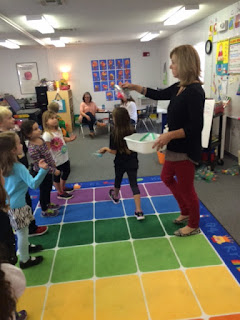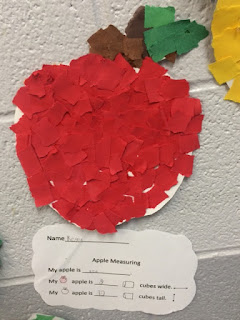Members of the Paine Elementary K-2 math OGAP Professional Learning Community had the opportunity to visit Leeds Elementary recently. Sessions on problem solving situations and counting collections were led by OGAP representative, Leah Pendergrass. Teachers were given the opportunity to observe these skills in practice in a first grade classroom. Teachers are looking forward to bringing this knowledge back to Paine as Mrs. Pendergrass visits and models effective problem solving and early numeracy strategies with K-2 teachers. Attending this day were kindergarten teachers Donna Walker and Gina Lackey, first grade teacher Jeanette Cerisano, and second grade teachers Kay Shumate and Beth Ann Marshall. Accompanying the teachers was math coach, Donna Brumlow
Mrs. Brumlow's Primary Math Blog
Saturday, January 30, 2016
Saturday, November 14, 2015
Peer Observation to Impact Learning
More and more, administrators and teachers are viewing peer observation as a form of collaborative professional development. This kind of observation can yield its greatest benefits when used as a means of sharing instructional techniques and ideologies between and among teachers.
Most important to effective teacher observation is that it be student-focused. The emphasis needs to be on how things can be done differently in the classroom to ensure that students succeed academically.
Kindergarten teachers at Paine Primary have been spending valuable time visiting each other's classrooms in order to learn from each other. Everyone benefits from this practice of "shared refining" of their craft.
Teachers benefit from:
* an opportunity to engage in reflective dialogue about their work.
* the focused classroom support.
* improvement of classroom practices.
* support from a peer who understands the daily demands of the classroom.
* satisfaction with one's work.
* reduced job stress, especially for the new teacher.
* a welcoming atmosphere for new teachers.
* the comfort of knowing that someone is available to help, explain, and assist.
The school benefits from:
* increased collaboration among teachers.
* the establishment of a professional learning community.
* an increased focus on student achievement.
* enthusiasm for the teaching profession.
Excerpts from post- Source: http://www.educationworld.com/a_admin/admin/admin297.shtml
"Teachers Observing Teachers: A Professional Development Tool for Every School"
Most important to effective teacher observation is that it be student-focused. The emphasis needs to be on how things can be done differently in the classroom to ensure that students succeed academically.
Kindergarten teachers at Paine Primary have been spending valuable time visiting each other's classrooms in order to learn from each other. Everyone benefits from this practice of "shared refining" of their craft.
Teachers benefit from:
* an opportunity to engage in reflective dialogue about their work.
* the focused classroom support.
* improvement of classroom practices.
* support from a peer who understands the daily demands of the classroom.
* satisfaction with one's work.
* reduced job stress, especially for the new teacher.
* a welcoming atmosphere for new teachers.
* the comfort of knowing that someone is available to help, explain, and assist.
The school benefits from:
* increased collaboration among teachers.
* the establishment of a professional learning community.
* an increased focus on student achievement.
* enthusiasm for the teaching profession.
Excerpts from post- Source: http://www.educationworld.com/a_admin/admin/admin297.shtml
"Teachers Observing Teachers: A Professional Development Tool for Every School"
Monday, October 26, 2015
Monday, October 12, 2015
Learning Targets- Aiming for Understanding
Learning targets, as their name implies, guide learning. They describe, in language that students understand, the lesson‑sized chunk of information, skills, and reasoning processes that students will come to know deeply. We write learning targets from the students’ point of view and share them throughout the lesson so that students can use them to guide their own learning. Finally, learning targets provide a common focus for the decisions that schools make about what works, what doesn’t work, and what could work better.
Daily Learning Targets around Paine Elementary K-2:
Daily Learning Targets around Paine Elementary K-2:
Wednesday, September 2, 2015
Math Around Paine Elementary K-2
Math is all around the Paine Elementary K-2 building! Students have been talking about the characteristics of mathematicians. They learned that they are all mathematicians! Students are using graphing skills to get to know each other. They counted the letters in their name and used number paths and ten frames to show the number.
Wednesday, August 26, 2015

It’s the beginning of the new school year, so what better time to think about the time-honored tradition of counting to the 100th Day of School? Many teachers have routines for counting the days to the 100th day, but I want to propose using ten-frames. You can address a number of Kinder and 1st grade standards with this simple daily routine!
Just print out blank ten-frames, grab yourself some colored Avery sticky dots, and you’re ready to go. Be sure to use either one color of dots, or vary the color in groups of 5 to help students subitize groups of 5 and 10 on the ten-frames.
Questions for Whole-Group Lessons:
There are so many directions you can take your questioning. To help you better visualize how the conversations might go, I’ve used the number 47 in this example:
•How many days have we been in school? (47) How do you know it’s 47? (The 4 tens are 40, then I saw 5 and 2 more, so that’s 47)
•Describe 47 using tens and ones. (4 tens and 7 ones) Can anyone describe it a different way? (3 tens and 17 ones, 2 tens and 27 ones, 1 ten and 37 ones, or 47 ones)
•How many more days until we reach 50 days (3). How do you know? How many more until the 100th day? (53) How do you know?
•What’s one more than 47? (48) What’s one less than 47? (46)
•How would we write 47 in expanded form? (47 = 40 + 7)
•Let’s start at 17 and count around the circle until we get to 47.
Monday, August 17, 2015
5 Principles of Extraordinary Math Teaching
1. Give students time to struggle
Students learn by grappling with mental obstacles and overcoming them. Your students MUST spend time stuck on problems. The more a teacher steps in to solve a student’s problems, the less the student learns. This is not to say you shouldn’t be involved in their process at all. Learn how to identify when your students are productively stuck—i.e. unable to answer the question but still making progress by making various attempts at understanding the problem—and when they are unproductively stuck—i.e. giving in to despair and hopelessness about the problem.Productively stuck students need little more than a bit of encouragement, reflection, or the occasional prompt from a teacher (best offered in the form of a question, such as “What have you done so far?” or “Have you tried ____?”). Unproductively stuck students need help scaffolding the problem, by rephrasing the question, identifying learning gaps, and possibly backing up to a more concrete or simpler problem. For both, time is critical: prioritize giving students the time required to let their perseverance flower.
2. Say yes to your students’ ideas
Doing math is creative work. It requires making connections between distinct concepts, translating knowledge into new contexts, and making intellectual leaps into unexplored territory. These are the hallmarks of creative thinking, and this is exactly the kind of capacity we want our students to develop. Creative work is hard, though, and becomes especially hard when the process of creative work is received with skepticism and negativity. When a student is working on a hard math problem, they are in a delicate place full of uncertainty, and a lot of the time the ideas they will have are wrong, or at least not exactly right. Many teachers want to point this out immediately to a student who is tentatively putting forth what to them is a novel idea on how to make sense of a math problem. However, to have an idea shut down means the student misses out getting to see why their idea might or might not work, and more importantly, they miss out on the exciting process of following wrong ideas into deeper understanding. We want our students to practice coming up with ideas and following them, even down rabbit holes, to see what they can discover.As a teacher, one of the best ways to support the creative growth of students is to say yes to their ideas. That doesn’t mean confirming the correctness of an idea, but it does mean refraining from pointing out the wrongness. Instead, encourage students to test out their ideas for themselves. Say yes to the creative act and respond “I don’t know—let’s find out!”
3. Don’t be the answer key
Most students will avoid hard work if they suspect there is an easier way. (Most people do this too. It’s an efficient strategy for handling a complex world with an abundance of information.) Unfortunately, there is no substitute for hard work when developing the mind. Students need to struggle with concepts themselves if they are going to understand or master them. They will not struggle if they believe that instead, they can ply the teacher for the answer. The teacher needs to avoid being seen as the source of all knowledge in the classroom.Rather, the teacher is the orchestrator of the classroom, setting up learning opportunities in which the students come to possess their own knowledge through grit, patience, and hopefully joy. Instead of using your knowledge to confirm to students when they have answered a problem right or wrong, encourage students to reference their own understanding of the problem and the mathematics behind it. If they don’t have the conceptual models at hand to check their understanding, help them build what they need.
4. Questions, questions, questions
Practice asking questions. Practice launching your lessons with questions and interacting with your working students by posing questions. Give your students opportunities to ask questions, and find ways to show them you value their questions. You can do this by using their questions to guide a lesson, having a special “Questions” board in the classroom, or making time for students to think of and write questions in a math journal.Not all questions will be answered, and that’s okay. (You are not the answer key, remember?) More important than answering all the questions is learning the practice of asking them in the first place. Students benefit from having the classroom be a place of questions. Questions keep the math classroom active, engaging, and full of surprises. For many students, developing the habit of asking questions about math, and seeing the teacher ask questions about math, marks the point in their elementary math lives when math truly comes alive.
5. Play!
Seriously. The more a teacher models a positive and excited disposition toward learning and especially mathematics, the more students will begin sharing in the fun. Find the parts of math that you love, and share your joy with the students. Look for opportunities to keep play at the center of the classroom: for example, introduce games to students by playing them (rather than just explaining them); give students an opportunity to play freely with math manipulatives; and be willing to play along when students try changing the rules of a game to invent their own variation.Avoid false enthusiasm: students know the difference. Find out how to get excited about math, and give yourself permission to play. Maybe for you this means being attentive to patterns, or finding really juicy questions to start a lesson with, or spending time making your own mathematical discoveries (remember how good an aha! moment feels?). Develop your own relationship with math and your students will benefit.
From the blog Math 4 Love
link: http://mathforlove.com/
Subscribe to:
Posts (Atom)




























